|
|
|
Sort Order |
|
|
|
Items / Page
|
|
|
|
|
|
|
| Srl | Item |
| 1 |
ID:
172381
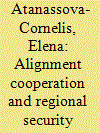

|
|
|
|
|
| Summary/Abstract |
Although the US-led system of formal alliances remains the main pillar of the regional security architecture in Asia, alignment cooperation – centred on the Indo-Pacific maritime conceptualisation of the region – has been on the rise. This includes informal bilateral and minilateral agreements for security collaboration between regional and extra-regional US treaty allies or close security partners, notably Japan, Australia, India, the United Kingdom and France. While the various alignments complement and address the deficiencies of the formal US-led alliances, the functional and informal characteristics of alignments allow countries to pursue security cooperation both in conjunction with the United States and independently of it. This leads to a more fluid security architecture that increasingly reflects the diversity of emerging regional ‘architects’, among which Japan is assuming a leading role, as much as the region’s array of new security challenges.
|
|
|
|
|
|
|
|
|
|
|
|
|
|
|
|
| 2 |
ID:
172384
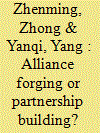

|
|
|
|
|
| Summary/Abstract |
Should China forge a military alliance? Some scholars believe it should, others believe it should adhere to a policy of non-alignment. For China many risks are associated with military alliances. On the one hand, China would likely be involved in unwanted conflicts and confrontations created by potential allies. On the other hand, China would be bound to compete with the existing hegemon, the United States, which has already established a huge alliance system, to win more allies. China just cannot afford this. The intensified strategic competition between China and the United States may also lead to a new antagonism in the Asia-Pacific region. Nevertheless, China’s ‘non-alliance’ policy does not mean China has to abandon the development of strategic cooperation with other countries or renounce the right to build a cooperative partnership network. Since Xi Jinping came to power, the Chinese government has continuously expanded its strategic partnership network in the region. This policy could avoid US-China competition over military allies and enhance strategic trust between China and its neighbouring countries, creating conditions for China’s peaceful development and global strategic stability.
|
|
|
|
|
|
|
|
|
|
|
|
|
|
|
|
| 3 |
ID:
172380
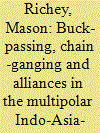

|
|
|
|
|
| Summary/Abstract |
Christensen’s and Snyder’s neorealist-based theory of buck-passing and chain-ganging uses offence-defence balance to predict state security policy choices under multipolarity. This approach is applicable to the US-led alliance system in the multipolar Indo-Asia-Pacific. Given regional Sino-US rivalry, hedging opportunities for US ‘hub-and-spoke’ allies will dissipate, increasing the likelihood of allies choosing to buck-pass or chain-gang in the face of conflict. With defence superior in the region, it is more likely that US allies will buck-pass rather than chain-gang. Beyond Indo-Asia-Pacific states, this has implications for global actors – such as the EU – seeking to raise their security profile in the region, as buck-passing behaviour gives greater time to adjust to potential conflict scenarios than chain-ganging.
|
|
|
|
|
|
|
|
|
|
|
|
|
|
|
|
| 4 |
ID:
172382
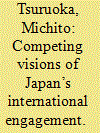

|
|
|
|
|
| Summary/Abstract |
The state and direction of Japan’s international engagement can best be understood as a competition between the ‘Japan first’ and ‘global Japan’ schools of thought. In light of the ever worsening security environment surrounding Japan, the gap between the Japan first school advocating a focus on the immediate needs of Japan’s territorial defence and the global Japan school arguing for more global engagement is widening. The competition between the two will continue to shape the direction of Japan’s foreign and security posture – and importantly, the global Japan school is far from winning, contrary to what Abe’s hyperactive diplomacy might suggest.
|
|
|
|
|
|
|
|
|
|
|
|
|
|
|
|
| 5 |
ID:
172383


|
|
|
|
|
| Summary/Abstract |
The Hanoi summit between the US and North Korea failed not because of North Korea’s brinkmanship strategy or its miscalculation of the US position on the denuclearisation talks, but because of a fundamental issue: a dilemma of how much to yield in giving up its military capabilities to expedite the lifting of sanctions. The leadership in Pyongyang has concerns about the ‘deliverability’ of its promises to its domestic audience to ensure deterrence capabilities and economic recovery. The two-level game model explains why both sides keep minimising the range of options for the negotiations, increasing the risk that the talks will break down.
|
|
|
|
|
|
|
|
|
|
|
|
|
|
|
|
| 6 |
ID:
172388
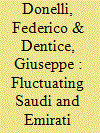

|
|
|
|
|
| Summary/Abstract |
The overthrow of Omar al-Bashir after three decades of rule has brought to light a dynamic that has been present for years: an interweaving of political, economic and security issues between the states of the Horn of Africa and the Gulf monarchies. Since 2011, the most active powers are the Kingdom of Saudi Arabia and the United Arab Emirates, which seek political support to counter both Iran’s influence and the growing Turkish presence. The two Gulf monarchies’ search for alignments with African counterparts has favoured the continuous reshuffling of alliances with direct effects on the local actors’ strategic choices. These dynamics need to be considered to understand the determinants behind the currently increasing instability in the Red Sea area.
|
|
|
|
|
|
|
|
|
|
|
|
|
|
|
|
| 7 |
ID:
172386


|
|
|
|
|
| Summary/Abstract |
Empirical studies in democracies have revealed some degree of causal relationship between public opinion and foreign policy. A look at the relationship between the evolution of Russian foreign policy priorities, as evidenced in the Foreign Policy Concepts (2000, 2008, 2013 and 2016), and public opinion regarding foreign policy measured from 1997 to 2018 shows significant shifts in perceptions of the nation’s international image. The amity/enmity feelings towards others can be explained as responses to key international events, endorsing the thesis of a rational and reactive public. Overall, public opinion and the official policy line in Russia move in the same direction.
|
|
|
|
|
|
|
|
|
|
|
|
|
|
|
|
| 8 |
ID:
172387
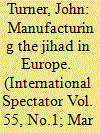

|
|
|
|
|
| Summary/Abstract |
As the Islamic State (IS) caliphate in the Middle East has collapsed, it is seeking to extend its influence elsewhere, particularly in Europe where there are existing inter-communal tensions to exploit. IS has deployed the management of savagery doctrine through acts of terrorism as part of its strategy to increase polarisation by exacerbating fear and distrust among communities, encouraging sympathies for far-right actors among non-Muslims and potentially alienating counterterrorism policies by governments, pushing Muslims out of what it terms the ‘grey zone’. The desired outcome is to drain state resources and showcase Europe as hostile to Muslims, promoting the notion of a ‘war on Islam’.
|
|
|
|
|
|
|
|
|
|
|
|
|
|
|
|
| 9 |
ID:
172385


|
|
|
|
|
| Summary/Abstract |
China’s growing power and assertiveness towards its smaller and weaker neighbours has been a wakeup call for the European Union and its member states which, as a result, have stepped up their involvement in East Asia. EU security policy in the region shows many elements of alignment with the United States, but also differences. In North East Asia, the EU has adopted harsh sanctions against North Korea but, contrary to the Trump administration which continues to seek regime change, has left the door open for dialogue. Moreover, the EU supports the process of trilateral cooperation among China, Japan and South Korea, while Washington has traditionally been lukewarm towards a process that excludes the US and risks being dominated by Beijing. The transatlantic allies also show differing approaches with regard to maritime disputes in the South China Sea. While EU security policy in East Asia is largely complementary to that of Washington, in some cases Europe tends – albeit inadvertently – to favour Beijing.
|
|
|
|
|
|
|
|
|
|
|
|
|
|
|
|
|
|
|
|
|